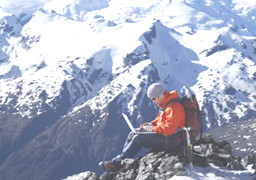




 |
 |
 |
|||
 |
 |
 |
 |
 | |
 |
 |
 | |


| 글로벌 트렌드 | 내서재담기 |


  |
 |  |
코로나19 위기 이전에, 미국의 노동자 5.3%만이 풀타임 원격근무를 했고, 23.7%는 하루 일부 시간만을 원격근무로 처리했다. 그러나 코로나19 대유행으로 인해 직장이 폐쇄되면서 원격근무 비율이 전 세계적으로 고공 행진 중이다. 이러한 변화는 우리의 경제 활동에 어떤 영향을 미칠 것인가? 부동산, 운송, 소매, 정보기술에 있어 의미하는 바는 무엇일까?
코로나19(COVID19) 위기 이전, 미국의 노동자 5.3%만이 풀타임 원격근무를 하는 것으로 보고되었다. 에노교통센터(Eno Centre for Transportation)에 따르면, 이 5.3%는 작은 수치로 보이지만 대중교통을 통해 출퇴근하는 미국인의 수보다 더 높은 수치다. 한편 미국의 노동자 23.7%는 일평균 일부 시간을 원격근무에 투입하는 것으로 나타났다. 이는 미국 노동 인구의 약 4분의 1이 이른바 원격근무에 대해 일정 수준의 경험을 지니고 있음을 의미한다.
그러나 코로나19 대유행으로 수많은 직장들이 폐쇄되면서 미국뿐만 아니라 전 세계적으로 원격근무 수치가 급등하고 있다. 실제로 코로나19 공중보건의 위기는 우리의 기본적인 일상생활의 많은 부분들에 대해 예기치 않은 스트레스 테스트(환율 변동이나 경기 침체처럼 외부에서 오는 위기에 회사들이 얼마나 잘 대처할 수 있는지 평가하는 일)를 만들었다. 다음과 같다.
- 사무실 통근
- 대면 회의
- 현대 경제에서 노동자의 의미를 제정의
사회적 거리두기(social distancing)가 수많은 곳에서 중단기적 의무 사항이 되면서, 고용주들이 주도하는 원격근무로의 전환은 현재의 위기와 그 이후의 모든 가정을 재설정할 태세다. 주목할 만한 점은 미국의 최대 고용주 연방 정부가 원격근무에 대한 새로운 지침을 발표했다는 것이다. 특히 백악관의 예산관리국(Office of Management and Budget)은 3월 말부터 워싱턴 D.C.의 정부 노동자들을 대상으로 각 부처에 원격근무의 유연성을 최대화할 것을 요구했다. 미국의 민간기업 중 두 번째로 큰 고용주인 아마존은 그 이전부터 시애틀과 벨뷰 본부의 직원들에게 3월 남은 기간 집에서 일하도록 요청했다.
이러한 원격근무의 급증은 화상 회의와 원격 데스크톱과 같은 원격근무를 가능하게 하는 기술들이 코로나19가 종식될 때까지 늘어난 트래픽을 처리할 수 있는지에 대한 의문을 제기하고 있다. 또한 가능한 많은 노동자들이 원격근무를 활용할 수 있도록 우리가 무엇을 해야 하는지에 대한 의문도 제기되고 있다. 동시에 이 위기는 우리가 직접 대면하지 않을 때 가치 손실이 발생하는지에 관해서도 재고를 요구하고 있다.
코로나19 위협에 대한 우리의 대응으로 원격근무의 중요성은 기술이 고용주가 다른 위험을 관리하는 데도 도움이 될 수 있음을 상기시킨다. 예를 들어, 원격근무를 통해 회사는 지속적인 혹은 치명적인 교통 체증으로 인한 생산성 손실 위험을 줄일 수 있다. 또한 원격근무를 혜택으로 제공하면 고용주가 고숙련 인력을 고용하는 데 드는 비용을 감당할 수 있고, 직원들이 어디에 있든 상관없이 사무실, 동료들과 연결할 수 있다. 더불어 원격근무를 통해 고용주는 더 큰 규모의 잠재적 노동자 그룹에 접근할 수 있으며 노동자들은 더 많은 일자리 옵션을 이용할 수 있다.
일부는 원격근무가 화이트칼라 노동자들에게만 혜택을 주는 한계가 있는 해결책이라고 비판해왔다. 그러나 간단하고 작은 솔루션이라도 여러 가지 시스템 문제에 의미 있는 영향을 줄 수 있다. 예를 들어, 가장 혼잡한 통근 시간대에서 약간의 인구만 빠져도 교통 혼잡은 크게 줄어들어 모두에게 도움이 된다. 또한, 원격 근무를 통해 사무실에서 직원들의 수가 줄어들면 더 작은 업무 공간만 필요하므로 수요가 높고 더 고가의 도심 지역에서 회사를 운영하는 것이 가능해질 뿐만 아니라 이로 인해 전체적으로 토지와 에너지 소비도 줄일 수 있다. 마지막으로, 원격근무자들이 커피숍과 코워킹 공간과 같은 제3의 지역에 대한 수요를 늘려 경제와 사회에도 도움을 준다.
코로나 바이러스에 대한 그리고 그 이상의 것에 대한 대응으로 원격근무자가 더 증가하면서, 필요한 것은 모든 이들에게 더 접근이 가능한 방향으로의 구조적 변화이다. 아메리칸 커뮤니티 서베이(American Community Survey)의 데이터에 따르면, 미국의 노동연령 성인의 거의 10%가 홈 광대역 인터넷을 갖추지 못하고 있다. 이들 중 거의 4 분의 1은 아예 서비스를 이용할 수 없거나, 그들 지역에서는 서비스 속도가 너무 느리다고 말한다. 광대역은 오래 전부터 사치품으로 여겨져 왔다. 하지만 코로나 바이러스로 인해 필수적인 원격근무로의 전환은 21세기 경제의 기능에 홈 광대역 인터넷이 필수적이라는 것을 분명히 보여주고 있다.
주목할 것은 온라인 쇼핑이 오프라인 소매점의 종말을 가져오지 않은 것처럼, 원격근무가 대면 업무와 사회적 상호작용의 이점을 없애지 않는다는 것이다. 또한 사회적 거리가 필요한 시점에 원격근무자가 생산성을 유지할 수 있는 동일한 기술을 활용하여 사회적 관계와 연결을 유지할 수 있다. 코로나 바이러스에 대한 대응이 원격근무를 포함한 디지털 연결이 우리가 살고 있는 각 장소를 더 강력하고 탄력적인 곳으로 만드는 유용한 도구임을 보여주고 있다.
이러한 기술과 상황을 고려할 때, 우리는 다음 7가지를 예측할 수 있다.
첫째, 당분간 미국에서 원격근무로의 대 이동은 인구의 최상위 소득 사분위에 집중될 것이다.
미 노동통계국(US Bureau of Labor Statistics)의 새로운 데이터에 따르면 최고 소득 사분 위에 있는 미국인의 약 60%가 셧다운 기간 집에서 일하고 있거나 일할 수 있는 것으로 나타났다. 한편 최저 소득 사분 위에 있는 사람들의 약 95%는 집에 머물러서는 생계를 유지할 수 없는 것으로 나타났다.
둘째, 더 많은 직원들이 원격근무자가 되면서 기업들은 사무 공간을 줄일 것이다.
원격근무로 인해 사무 공간을 줄이는 것은 대부분의 CEO들에게 가장 높은 우선순위가 될 것이다. 모든 것이 정상으로 돌아가더라도 이에 대한 경제적 여파는 상당할 것이다. 미국의 주요 상업용 부동산 중개인들은 2020년에 사무 공간의 완만한 성장을 이미 예상하고 있었다. 기술 기업들과 전문 서비스 기업들이 이러한 성장의 상당 부분을 차지한다. 그러나 이들 기업들은 원격근무를 통해 더 작은 사무 공간을 활용할 수 있는 유형의 기업들이다. 일반적 기업들의 직원들은 125-225 평방피트의 공간을 차지한다. 전체 직원의 약 20%, 즉 약 3천만 명이 오늘날 미국의 사무실에서 근무한다고 가정하면, 이는 약 40억 평방피트로 해석할 수 있다. 그렇다면 그러한 노동자들의 20%가 집에서 일을 시작하고 회사는 그만큼의 사무 공간을 줄인다면 그것이 경제에 미치는 영향을 상상해보자. 약 8억 평방피트의 공간이 비게 된다. 사무 공간 비용은 미국마다 크게 다르지만, 가장 높은 비용의 사무 공간부터 규모가 줄어들 것으로 가정하면, 평방피트당 연간 30달러의 임대료를 적용하는 것이 합리적일 것이다. 이는 사무 공간 임대료가 연간 240억 달러 감소되는 것으로 해석할 수 있다. 사무직 직원의 절반이 원격근무로 이동하면 연간 600억 달러의 임대료 손실이 발생한다. 이 남은 공간은 어떻게 될까? 대부분은 주거지가 되는 것일까? 이는 뉴욕, 시카고, 로스 앤젤레스 및 기타 대도시에서 도심 주택을 구매할 여유가 없는 사람들에게 유리한 상황이 될 것이다.
셋째, 원격근무의 증가로 인해 통근 시간과 비용이 줄어들 것이다.
2020년대 중반 무인 자동차의 영향을 고려하기 이전에 원격근무로 줄어드는 차량과 연료 소비에 대한 생각해 보자. 1920년대 이래로 우리가 알고 있던 물리적 이동형 사회는 우리가 가정 내에서 세계에 접근하는 사회로 대체될 것이다. 오늘날, 제안되고 있는 사회 인프라의 촉진 요소는 대부분 고속도로 건설, 통근 열차와 관련이 있다. 따라서 기존 교통 시스템을 유지 관리하고 업그레이드하는 것에서 벗어남으로써, 물 프로젝트, 에너지 파이프라인, 공항 및 전기 전송 시스템에 더 많은 돈을 투입할 수 있을 것이다. 가장 중요한 것은, 원격근무에 필요한 초고속 광대역이다. 5G가 이에 대한 해결책이 될 것이다.
넷째, 최적화된 원격근무는 실리콘 밸리와 같이 고도로 밀집된 고가의 지역에서 벗어나 비용이 좀 더 저렴한 타 지역의 인재들을 효과적으로 활용하는 수단을 제공해줄 것이다.
천문학적 생활비와 통근 시간은 실리콘 밸리와 같이 밀집된 기술 허브가 인재를 유치하기 위해 엄청난 임금과 주식 옵션을 지불해야 함을 의미한다. 원격근무를 수용하는 문화적 전환으로 기업들은 필요한 인재를 저렴한 비용으로 유치할 수 있을 것이다. 이민에 대한 제한이 더 엄격해지면서, 미국 전역 혹은 전 세계에 분산된 첨단 인력은 더욱 중요해질 것이다.
다섯째, 원격근무의 증대로 일과 삶의 균형이 더 큰 도전과제가 될 것이다.
하루 24시간, 주 7일(24/7) 문자 메시지, 전자메일, 통화의 세계에서, 경영자들과 전문 직원들이 서로의 개인적 삶을 방해하지 않는 시간을 찾기란 쉽지 않은 일이다. 여기에 이제 모든 사람이 전체적인 근무 자원에 24/7의 접근을 시도할 수 있는 상황을 상상해보라. 일과 삶의 구분이 모호해지는 일은 언제 어디서나 발생할 수 있다. 또한 일에 대한 욕심이 있거나 승진을 목표로 하는 사람들의 경우, 그들이 일할 수 있는 환경에서 일하지 않는 것에 대해 불안을 느낄 수도 있다.
여섯째, 사람들이 더 넓은 범위의 지역에서 근무함에 따라 사이버 보안 문제가 더욱 시급해질 것이다.
아이러니하게도, 원격근무를 최전선으로 밀고 있는 위기가 사이버 범죄와 사이버 전쟁의 위협을 증가시키고 있다. 이는 사이버 보안 산업에서 신뢰할 수 있는 기업들이 더욱 더 필수불가결한 존재가 됨을 의미한다. 그러나 취약성의 주요 원인은 ‘인적 오류’이다. 사이버 보안 도구를 제대로 사용하지 못하거나, ‘피싱 사기’에 빠지거나, 쉽게 추측할 수 있는 암호 사용 등에 이르는 모든 것이 포함된다. 따라서 기업들은 모두 데이터에 대한 올바른 처리를 직원들이 할 수 있도록 교육하고, 직원들로 하여금 이 문제가 가장 중요하다는 점을 인지시켜야 할 것이다.
일곱째, 장기적인 관점에서 원격근무 채택은 새로운 행동과 도구를 필요로 할 것이다.
현재의 위기를 극복하기 위해 임시 근무처로서의 재택이 장기적으로 생산성의 극대화를 목표로 한다면 일하기에 적합한 더 탄탄한 곳으로 변모해야 할 것이다. 그러기 위해서는 원격근무자들에게 새로운 직업윤리와 문화가 필요하고, 더욱 진화된 도구가 주어져야 한다. 이로 인해 스카이프(Skype)에서 줌(Zoom), 웹엑스(Webex)와 같은 원격회의 서비스를 제공하는 기업들은 가장 큰 승자가 될 가능성이 있다. 또한 원격근무 하나만으로도 북미, 유럽, 한국, 일본에서 5G를 더 빠르게 구축 할 수 있는 근거를 제공할 것이다.
* *
References List :
1. March 15, 2018. Dan Kopf. Slowly but surely, working at home is becoming more common.
https://qz.com/work/1392302/more-than-5-of-americans-now-work-from-home-new-statistics-show/
2. May 31, 2018. David C. Smith. Top Trends and Metrics to Watch in Office Space.
http://blog.naiop.org/2018/05/top-trends-and-metrics-to-watch-in-u-s-office-space/
3. HBS: Working Knowledge. March 30, 2020. Kristen Senz. How Companies Benefit When Employees Work Remotely.
https://hbswk.hbs.edu/item/how-companies-benefit-when-employees-work-remotely
4. The Boston Herald. August 10, 2019. Alexi Cohan. Impact of telecommuting tax credit to ease Boston traffic debated.
https://www.bostonherald.com/2019/08/10/impact-of-telecommuting-tax-credit-to-ease-boston-traffic-debated/
5. com December 24, 2019. Tracy Hadden Loh and Jennifer S. Vey. Retail isnt dead. Its just changing.
https://edition.cnn.com/2019/12/24/perspectives/retail-2020/index.html
6. com. 04/08/2020. Charlie Stephens. COVID-19: A CALL TO CONNECT.
https://www.newgeography.com/content/006590-covid-19-a-call-to-connect
7. com. 04/24/2020. Prakash Loungani. A LOOK AT DEMOGRAPHIAS LATEST HOUSING AFFORDABILITY SURVEY.
https://www.newgeography.com/content/006590-covid-19-a-call-to-connect
8. HBS: Working Knowledge. March 30, 2020. Dina Gerdeman. The New Rules for Remote Work: Pandemic Edition.
https://hbswk.hbs.edu/item/the-new-rules-for-remote-work-pandemic-edition
9. com. 04/01/2020. Marshall Toplansky. THE FUTURE OF OFFICE SPACE REAL ESTATE MARKET.
https://www.newgeography.com/content/006597-the-future-office-space-real-estate-market
10. The Brookings Institution. March 17, 2020. Tracy Hadden Loh and Lara Fishbane. COVID-19 makes the benefits of telework obvious.
https://www.brookings.edu/blog/the-avenue/2020/03/17/covid-19-makes-the-benefits-of-telework-obvious/
11. com. April 11, 2020. Andreas Kluth. This Pandemic Will Lead to Social Revolutions.
https://www.bloomberg.com/opinion/articles/2020-04-11/coronavirus-this-pandemic-will-lead-to-social-revolutions
 |  |
The New World of Telework is Upon Us
Before the COVID19 crisis, just 5.3 percent of U.S. employees reported telecommuting most of the time. And while 5.3% may seem small, that’s more than the number of Americans who commute via mass transit, according to the Eno Center for Transportation. Meanwhile, 23.7% said they worked some hours from home on an average day, meaning that about a quarter of the population had at least a little experience with so-called “telework.”
Yet now, with the pandemic shuttering workplaces, that figure has skyrocketed, not just in the U. S., but globally. In effect, the COVID-19 public health crisis has created an unexpected stress-test for many parts of our basic daily routine including:
- commuting to the office,
- face-to-face meetings, and even
- redefining what it means to be a “worker” in the modern economy.
With “social distancing” becoming a medium-term imperative in many places, employers’ transition to telework is poised to remake all of those assumptions, for the current crisis and beyond.
Notably, the nation’s largest employer, the federal government, has issued new guidance on telework. Specifically, the White House’s Office of Management and Budget urged agencies to “maximize telework flexibilities” for workers in the Washington, D.C. region, beginning in late March. Days before that, Amazon, the nation’s second-largest private employer, asked its Seattle and Bellevue-based headquarters employees to work from home for the remainder of March.
This surge in teleworking raised questions about whether the technologies that enable telework, such as video conferencing and remote desktops, could scale to handle the increased traffic associated with the COVID19 shutdown. It also raised the question, what we can do to ensure as many workers as possible are able to take advantage of telework? At the same time, the crisis also forced us to reconsider whether there is a loss of value when we don’t work face-to-face.
The prominence of telework in our response to the COVID19 threat is a reminder that technology can help employers manage other risks, as well. For example, telework can enable firms to reduce the risk of losing productivity to regular or catastrophic traffic disruption. Offering telework as a benefit can help employers afford the cost of hiring high-skill labor, and keep these workers connected to the office and each other no matter where they’re based. Teleworking’s reach also allows employers access to a larger group of potential workers and, in turn, allows workers access to more job options.
Some have criticized telework as a marginal solution that benefits only white-collar workers. But even a simple, small solution can have a meaningful impact on multiple systemic problems. For example, even modest reductions in peak commuting activity can dramatically decrease traffic congestion, which benefits everyone. Furthermore, locating in an in-demand, high-cost urban area is more affordable for an employer when telework allows them to consume fewer square feet per worker, reducing land and energy consumption. Finally, the economy and society enjoy increased stimulus from workers who telecommute from “third places” such as coffee shops and coworking spaces.
As more workers transition to remote work in response to the coronavirus and beyond it, there are structural changes that must be addressed to make it more accessible for everyone. Nearly 10% of working-age adults do not have a home broadband connection, according to American Community Survey data. Nearly a quarter of these broadband nonadopters say that services aren’t available or are too slow where they live. Broadband has long been considered a luxury good, but the transition to mandatory telework due to coronavirus makes it clear that an in-home connection will be vital to the functioning of the 21st-century economy.
Notably, telework does not eliminate the benefits of face-to-face work and social interaction, just as online shopping isn’t the end of brick-and-mortar retail. Furthermore, at a time that requires social distancing, the same technologies that enable remote workers to stay productive can be leveraged to maintain social ties and connections. The coronavirus disruption is demonstrating that digital connectivity, including telework, is a valuable tool that makes places stronger and more resilient.
Given this trend, we offer the following forecasts for your consideration.
First, in the U.S., the big shift to telework will be concentrated within the top income quartile of the population.
New data from the U.S. Bureau of Labor Statistics indicates that roughly 60% of Americans in the top income quartile are, or could be, working from home during the shutdown. Meanwhile, roughly 95% of the people in the bottom income quartile can’t stay at home and earn a living.
Second, companies will shed office space as more employees become teleworkers.
Shedding office space will be a high priority for most CEOs once things “get back to normal” and the economic impact could be significant. Major commercial real estate brokers were already projecting modest growth for office space in 2020. Technology companies and professional services firms comprise a significant portion of that growth. And these are the types of companies that are most likely to be able to take advantage of smaller office footprints via telework. The typical employee takes up between 125 and 225 usable square feet of space in an office. If we assume that roughly 20% of total employees, or about 30 million people, work in offices today in the United States, that translates into about 4 billion square feet. Just imagine the impact on the economy if 20 percent of those workers started working from home and their companies shed their office space; that means 800 million square feet of space would become vacant. Office costs vary greatly across the United States, but if we assume that the highest cost offices would be the first to be downsized, it would be reasonable to use a rental cost of $30 per square foot per year. That translates into $24 billion in lower office rents in the U.S. on an annual basis. If half the office workers went virtual, it would come to $60 billion in lost rents per year. What would happen to that space, most of it would likely become residential? This would be great for those who can’t now afford urban housing in New York, Chicago, Los Angeles, and many other big cities.
Third, the rise of telework means less commuting time and costs.
Imagine fewer cars per capita, and less fuel consumption per car even before we factor in the impact of driverless vehicles by the mid-2020s. The mobile society we’ve known since the 1920s will be replaced by one in which we increasingly access the world from home. Today, a big part of the proposed infrastructure stimulus involves highways and commuter rail. Yet, except for maintaining and upgrading existing systems, that money would be better spent on water projects, energy pipelines, airports, and transmission systems for electricity. Most importantly, teleworking requires higher-speed broadband with 100% penetration; 5G is the likely solution.
Fourth, optimized telework will create a means of effectively harnessing less expensive talent outside of densely packed, overpriced locations like Silicon Valley.
Astronomical living costs and commute times mean that densely packed tech hubs like Silicon Valley must pay exorbitant wages and stock options in order to attract talent. A cultural shift toward embracing telework will enable those firms to attract the talent they need at a lower cost. And, with increased restrictions on immigration, a high-tech workforce dispersed across the country and around the world will become more important.
Fifth, increased telework will make work-life balance a bigger challenge.
In the world of 24/7 text messages, emails, and phone calls, it’s hard enough for managers and professionals to find uninterrupted time for their personal lives. Now, imagine a situation where everyone has access to their full suite of vocational resources, 24/7. Suddenly staff and client meetings can happen anytime and anywhere. Ambitious people will increasingly feel that anytime they aren’t working is being “wasted.” At the same time, people will wonder why they “don’t’ have a life.”
Sixth, cybersecurity issues will become even more pressing as people work from a wider range of locations.
Ironically, the same crisis that’s pushing telework to the forefront is increasing the threat of cybercrime and cyberwarfare as we hinted in trend #1, this month. This means that trusted companies in the cybersecurity business will become more indispensable. However, the primary source of vulnerability will remain “human error.” This includes everything from failure to properly use cybersecurity tools, to falling for “phishing scams,” to using easily guessed password. Therefore, it will become crucial for every company to sensitize its employees regarding the proper handling of mission-critical data. And,
Seventh, long-term adoption of telework will require a new set of behaviors and tools.
The make-shift home offices used for the current crisis will have to become more robust if they are to maximize productivity, long-term. Importantly, teleconferencing services ranging from Skype to Zoom to Webex are poised to become big winners as lots of people use them for the first time. Telework alone provides the rationale for a rapid build-out of 5G in North America, Europe, South Korea, and Japan.
References
1. March 15, 2018. Dan Kopf. Slowly but surely, working at home is becoming more common.
https://qz.com/work/1392302/more-than-5-of-americans-now-work-from-home-new-statistics-show/
2. May 31, 2018. David C. Smith. Top Trends and Metrics to Watch in Office Space.
http://blog.naiop.org/2018/05/top-trends-and-metrics-to-watch-in-u-s-office-space/
3. HBS: Working Knowledge. March 30, 2020. Kristen Senz. How Companies Benefit When Employees Work Remotely.
https://hbswk.hbs.edu/item/how-companies-benefit-when-employees-work-remotely
4. The Boston Herald. August 10, 2019. Alexi Cohan. Impact of telecommuting tax credit to ease Boston traffic debated.
5. com December 24, 2019. Tracy Hadden Loh and Jennifer S. Vey. Retail isnt dead. Its just changing.
https://edition.cnn.com/2019/12/24/perspectives/retail-2020/index.html
6. com. 04/08/2020. Charlie Stephens. COVID-19: A CALL TO CONNECT.
https://www.newgeography.com/content/006590-covid-19-a-call-to-connect
7. com. 04/24/2020. Prakash Loungani. A LOOK AT DEMOGRAPHIAS LATEST HOUSING AFFORDABILITY SURVEY.
https://www.newgeography.com/content/006590-covid-19-a-call-to-connect
8. HBS: Working Knowledge. March 30, 2020. Dina Gerdeman. The New Rules for Remote Work: Pandemic Edition.
https://hbswk.hbs.edu/item/the-new-rules-for-remote-work-pandemic-edition
9. com. 04/01/2020. Marshall Toplansky. THE FUTURE OF OFFICE SPACE REAL ESTATE MARKET.
https://www.newgeography.com/content/006597-the-future-office-space-real-estate-market
10. The Brookings Institution. March 17, 2020. Tracy Hadden Loh and Lara Fishbane. COVID-19 makes the benefits of telework obvious.
11. com. April 11, 2020. Andreas Kluth. This Pandemic Will Lead to Social Revolutions.
